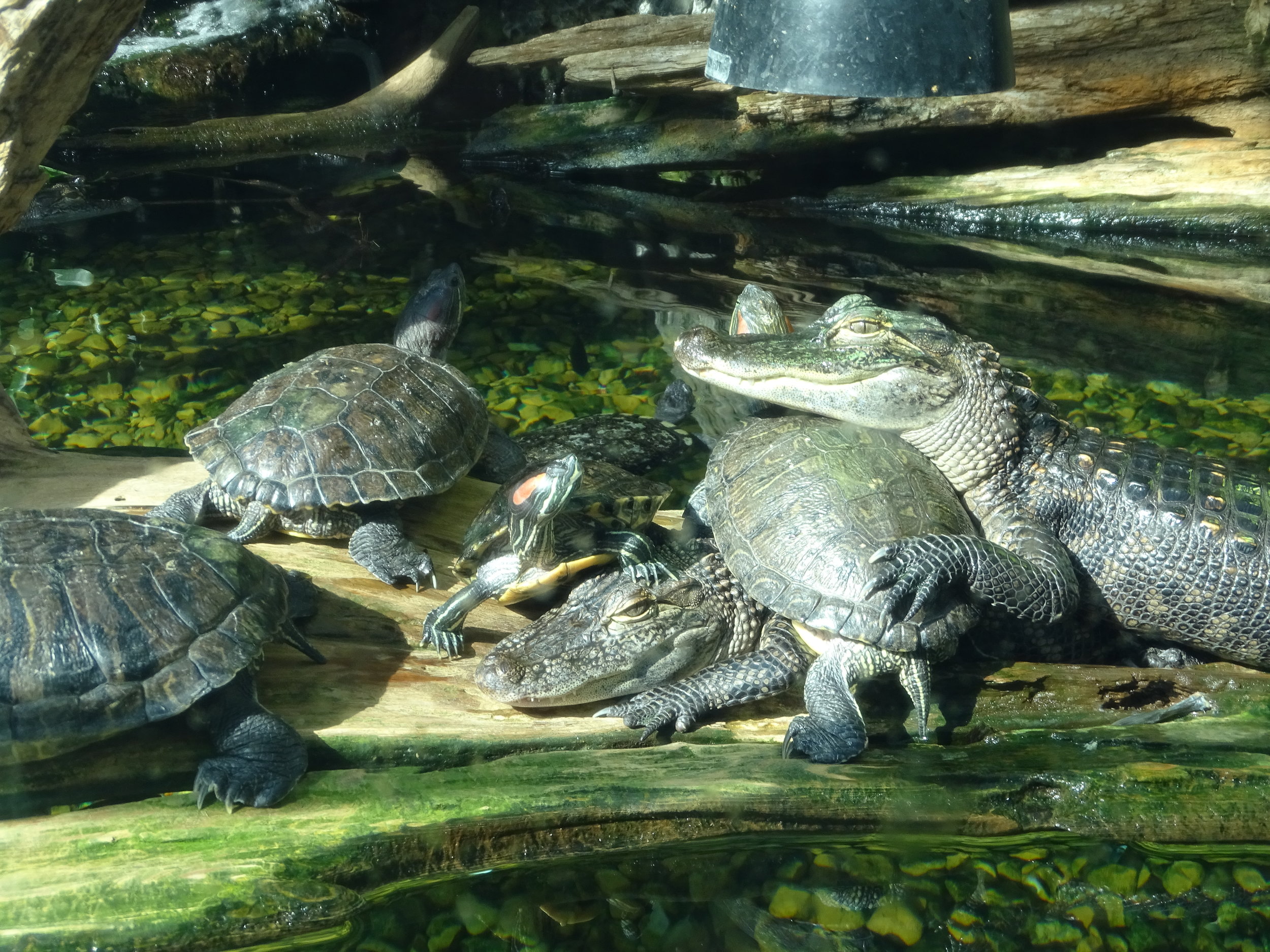Mississippi: Make One-Stop to Learn about Nature and Walk Through It on the Same Day
Turtles and alligators hang out together at the Mississippi Museum of Natural Science where they cheerfully follow the rule about not eating your friends.
MISSISSIPPI MUSEUM OF NATURAL SCIENCE
Managed by the Mississippi Department of Wildlife, Fisheries and Parks, the Mississippi Museum of Natural Science (2148 Riverside Drive) focuses on what you would find when exploring nature in the state. You might think that would limit the scope of what is covered, but Mississippi is one of the most biologically diverse states in America, so there’s plenty to see.
Turtles and alligators coexist in the museum’s terrarium.
Surprisingly turtles and alligators make good friends.
Our favorite exhibit was a 1,700-square-foot terrarium called “The Swamp.” It contains native plants and provides a home for alligators, turtles and fish. It shocked us to see alligators and turtles huddling together under heat lamps. We thought the alligators would eat the turtles, but we learned that what’s happening in the terrarium also happens in natural settings, where turtles will sometimes climb on an alligator’s bench and use it as a floating dock.
The museum frequently brings in special exhibits such as Dinosaurs Around the World.
A moving, screaming dinosaur greets Linda and Arla outside the Mississippi Museum of Natural Science.
We also enjoyed seeing the special exhibition of Dinosaurs Around the World. The exhibition makes it fun for children and adults to learn about dinosaurs in a playful and educational environment. The exhibit runs through January 2020. Whatever season of the year you visit the museum, you’ll find it an engaging visual learning environment with special events held throughout the year. See the Bulletin Board on the museum’s website for details.
Nature Trails
The trails accessible from the museum are all less than one mile long, with the shortest (Old Pond Trail) being .16 miles and mostly paved. The trails go through wooded bluffs, river bottoms, lakes and scenic swamplands. They are ideal for nature walks, photography and studying living things in their environment.
Pearl River Trail
The longest of the trails travels along the banks of the Pearl River and ends at Mayes Lake in LeFleur’s Bluff State Park. This trail is .81 miles one way and includes a mix of boardwalks and dirt paths.
Lake Mayes serves as the top scenic attraction and fishing hole at LeFleur’s Bluff State Park.
LEFLEUR’S BLUFF STATE PARK
The Mississippi Wildlife, Fisheries and Parks describes this 305-acre park perfectly. “LeFleur’s Bluff provides a lush green spot in the heart of urban Jackson.” It surprised us to find a park near a city center and next to an interstate that creates the impression of having left the city for a trip to the mountains or wilderness area. Another park feature is the nine-hole golf course and a public driving range. Of course, separate fees are charged to use them. A free nine-basket disc golf course is adjacent to Mayes Lake.
Arla wonders what it would be like to see the plastic dinosaurs at the museum entrance do more than wiggle and make a lot of noise. She’d like to see them start running.
ARLA’S SHOCKING MOMENT
Arla: As soon as Doug parked the car at the Mississippi Museum of Natural Science, I spotted three dinosaurs roaming in front of the building about 20 yards away from us. Not expecting to see them, I thought that somebody could get scared to death here.
Of course, the dinosaurs were only giant plastic models, but they looked real to me, especially because they twisted and turned while the sounds of dinosaurs in distress boomed out of speakers. I wish the creators of these faux dinosaurs could make them capable of walking or running. That would have been much more frightening to see. As is, the dinosaurs left a few museum visitors on the verge of tears. OK, I’ll admit to exaggerating the fear factor. The frightened victims were 2-year-olds.
Linda’s Takeaway
A highlight of my visit to the Museum of Natural Science was learning the history of the Teddy Bear. I found out that the Teddy Bear was invented in honor of President Theodore Roosevelt. It started in 1902 when Roosevelt was bear hunting in Mississippi and spared a bear’s life.
DOUG’S HISTORICAL FEATURE
Doug: LeFleur’s Bluff State Park is named for Louis LeFleur, a frontiersman and explorer, who established a trading post on the banks of the Pearl River in the late 1700s. The city of Jackson was originally known as "LeFleur's Bluff."
LeFleur was born in a tiny French colony surrounding Ft. Conde on the Gulf of Mexico, which now is Mobile, Ala. He traded goods across present-day Mississippi and beyond using flatboats or keelboats to reach settlers and Native Americans seeking essentials and luxury items in the wilderness. He adopted the Choctaw practice of polygamy and married two Choctaw sisters. One of his children became the last chief of the Choctaw Nation.
GEE WHIZ FACTS (FROM THE MUSEUM)
American alligators can grow up to 14 feet in length and can weigh up to 1,000 pounds. They can live from 30 to 50 years.
The female alligator builds a nest and lays about 30 eggs in the spring. The eggs hatch after approximately 90 days and the young will stay with the mother for about two years.
The name alligator probably comes from the Spanish term for “the lizard,” which would be “el lagarto.”
Historically, alligators may have been found across Mississippi, but today they are only known to inhabit the lower two-thirds of the state.
PARTING SHOTS: SURPRISING SCENIC NATURE IN AN URBAN PARK

















